Financial Management Chapter Notes | Business Studies (BST) Class 12 - Commerce PDF Download
| Table of contents |

|
| Introduction |

|
| Financial Decisions |

|
| Financial Planning |

|
| Capital Structure |

|
| Fixed Capital |

|
| Working Capital |

|
Introduction
- The money required for carrying out business activities is called business finance.
- Finance is needed to establish a business, to run it, to modernize it, to expand or diversify it.
- Financial management is the activity concerned with the planning, raising, controlling and administering of funds used in the business.
- It is concerned with optimal procurement as well as usage of finance.
- It aims at ensuring the availability of enough funds whenever required as well as avoiding idle finance.
Objectives of Financial Management
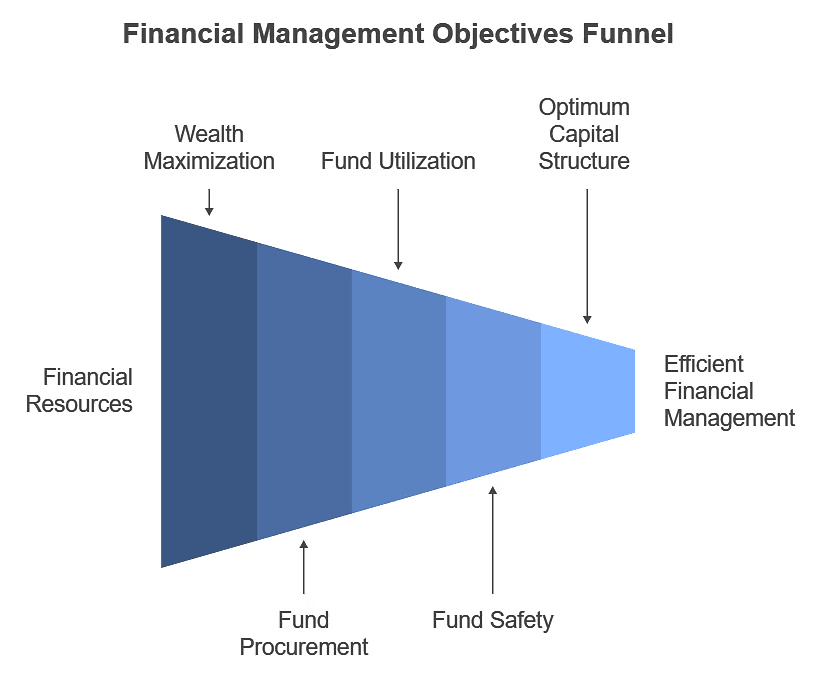
1. Wealth Maximization: The main objective of Financial management is to maximize shareholder’s wealth, for which achievement of optimum capital structure and proper utilization of funds is a must.
2. To procure sufficient funds for the organization: An adequate and regular supply of funds is to be maintained for smooth operations of the business.
3. To ensure effective utilization of funds.
4. To ensure the safety of funds: The chances of risk in investments should be minimal.
5. To attain optimum capital structure: A sound and economical combination of shares and debentures must be attempted so as to maintain optimum capital structure.
Financial Decisions

Every company is required to make three main financial decisions which are as follows:
1. Investment Decision
It relates to how the firm’s funds are invested in different assets. Investment decisions can be long-term or short-term. A long-term investment decision is called a capital budgeting decision as they involve huge amounts of funds and are irreversible except at a huge cost while short-term investment decisions are called working capital decisions, which affect day to day working of a business.
Factors affecting Investment Decisions/Capital Budgeting decisions
1. Cash flows of the project: The series of cash receipts and payments over the life of an investment proposal should be considered and analyzed for selecting the best proposal.
2. Rate of Return: The expected returns from each proposal and the risk involved in them should be taken into account to select the best proposal.
3. Investment Criteria Involved: The various investment proposals are evaluated on the basis of capital budgeting techniques. These involve calculations regarding investment amount, interest rate, cash flows, rate of return etc.
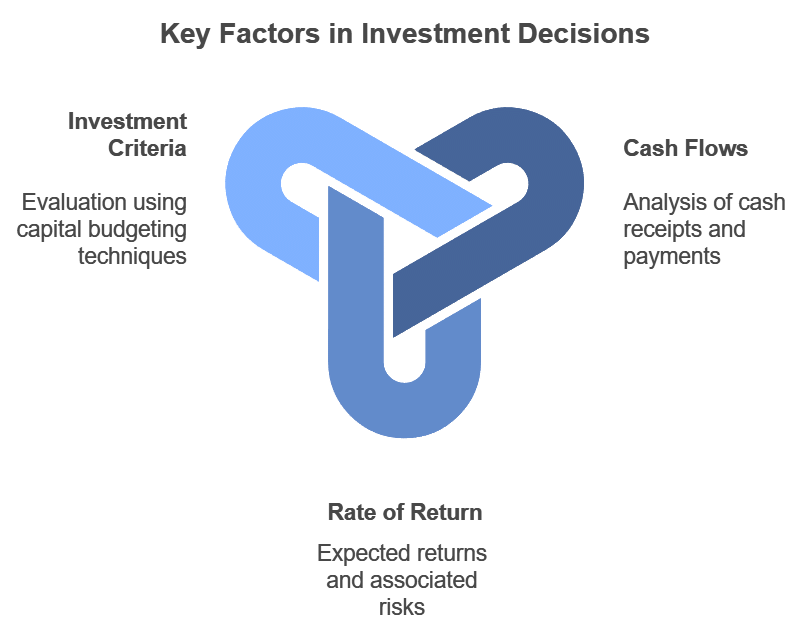
2. Financing Decision
It relates to the amount of finance to be raised from various long-term sources. The main sources of funds are owner’s funds i.e. equity/shareholder’s funds and the borrowed funds i.e. Debts. Borrowed funds have to be repaid at a fixed time and thus some amount of financial risk (i.e. risk of default on payment) is there in debt financing. Moreover, interest on borrowed funds has to be paid regardless of whether or not a firm has made a profit. On the other hand, a shareholder’s fund involves no commitment regarding payment of returns or repayment of capital. A firm mixes both debt and equity in making financing decisions.
Factors Affecting Financing Decision:
1. Cost: The cost of raising funds from different sources is different. The cheapest source should be selected.
2. Risk: The risk associated with different sources is different. More risk is associated with borrowed funds as compared to owner’s funds as interest is paid on it and it is repaid also, after a fixed period of time or on the expiry of its; tenure.
3. Flotation Cost: The costs involved in issuing securities such as brokers' commission, underwriters’ fees, expenses on prospectus etc. are called flotation costs. The higher the flotation cost, the less attractive is the source of finance.
4. Cash flow position of the business: In case the cash flow position of a company is good enough then it can easily use borrowed funds and pay interest on time.
5. Control Considerations: In case the existing shareholders want to retain complete control of the business then finance can be raised through borrowed funds but when they are ready for dilution of control over the business, equity can be used for raising finance.
6. State of Capital Markets: During a boom, finance can easily be raised by issuing shares but during the depression period, raising finance by means of debt is easy.
7. Period of Finance: For permanent capital requirement, Equity shares must be issued as they are not to be paid back and for long and medium-term requirements, preference shares or debentures can be issued. Dividend refers to that part of the profit which is distributed to shareholders. A company is required to decide how much of the profit earned by it should be distributed among shareholders and how much should be retained. The dividend decision should be taken keeping in view the overall objective of maximizing shareholder wealth.
3. Dividend Decision
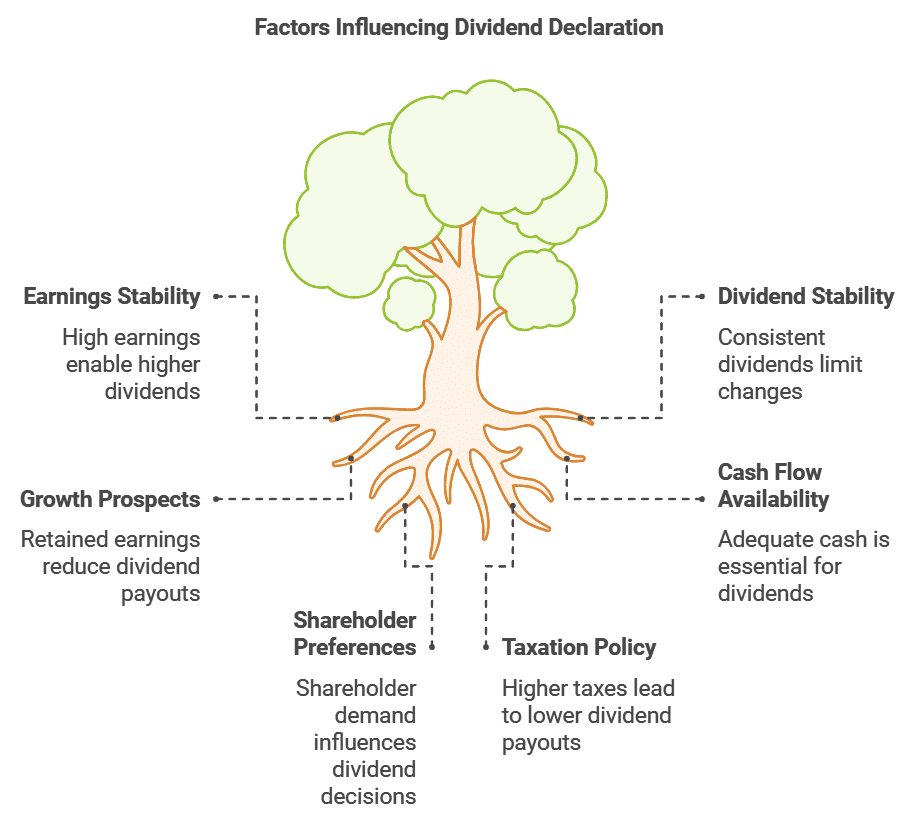
Factors Affecting Dividend Decision:
1. Earnings: Companies having high and stable earnings could declare a high rate of dividends as dividends are paid out of current and past earnings.
2. Stability of Dividends: Companies generally follow the policy of stable dividends. The dividend per share is not altered and changed in case earnings change by a small proportion or an increase in earnings is temporary in nature.
3. Growth Prospects: In case there are growth prospects for the company in the near future it will retain its earnings and thus, no or less dividend will be declared.
4. Cash Flow Positions: Dividends involve an outflow of cash and thus, the availability of adequate cash is for most requirement for the declaration of dividends.
5. Preference of Shareholders: While deciding about dividends the preference of shareholders is also taken into account. In case shareholders desire for dividend then the company may go for declaring the same.
6. Taxation Policy: A company is required to pay tax on dividends declared by it. If the tax on dividends is higher, the company will prefer to pay less by way of dividends whereas if tax rates are lower then more dividends can be declared by the company.
7. Issue of bonus shares: Companies with large reserves may also distribute bonus shares to increase their capital base as it signifies the growth of the company and enhances its reputation.
8. Legal constraints: Under provisions of the Companies Act, all earnings can’t be distributed and the company has to provide for various reserves. This limits the capacity of the company to declare dividends.
Financial Planning
The process of estimating the fund requirement of a business and specifying the sources of funds is called financial planning. It ensures that enough funds are available at the right time so that a firm can honour its commitments and carry out its plans.
Importance of Financial Planning
1. To ensure the availability of adequate funds at the right time.
2. To see that the firm does not raise funds unnecessarily.
3. It provides policies and procedures for the sound administration of finance functions.
4. It results in the preparation of plans for the future. Thus new projects can be undertaken smoothly.
5. It attempts to achieve a balance between the inflow and outflow of funds. Adequate liquidity is ensured throughout the year.
6. It serves as the basis of financial control. The management attempts to ensure the utilisation of funds in tune with the financial plans.
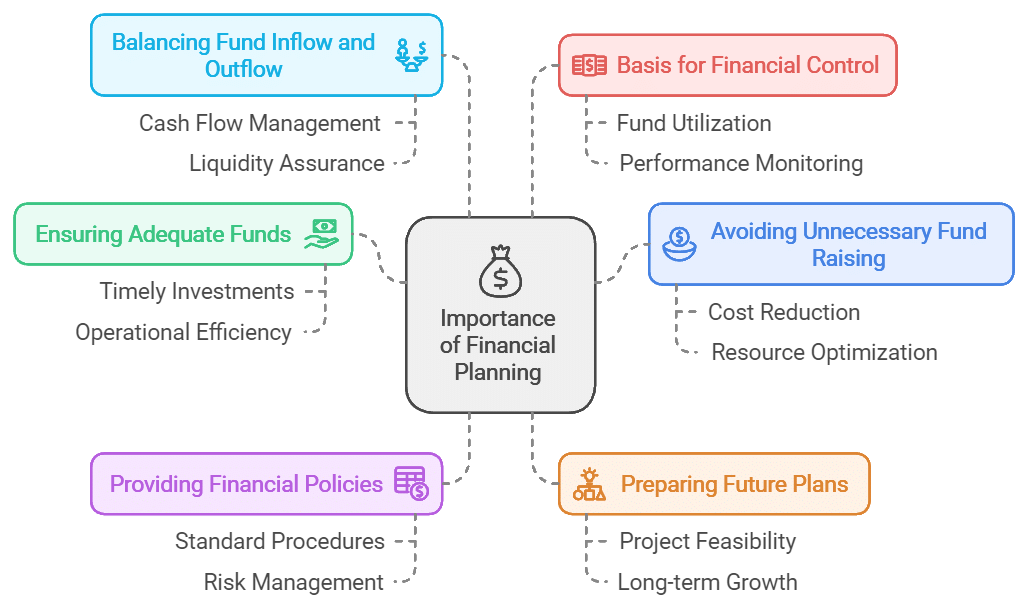
Capital Structure
Capital structure refers to the mix between owner’s funds and borrowed funds. It will be said to be optimal when the proportion of debt and equity is such that it results in an increase in the value of the equity share. The proportion of debt in the overall capital of a firm is called Financial Leverage or Capital Gearing. When the proportion of debt in the total capital is high then the firm will be called a highly levered firm but when the proportion of debts in the total capital is less, then the firm will be called a low levered firm.
Factors Affecting Capital Structure:
1. Trading on Equity: t refers to the increase in profit earned by the equity shareholders due to the presence of fixed financial charges like interest. Trading on equity happens when the rate of earning of an organization is higher than the cost at which funds have been borrowed and as a result, equity shareholders get a higher rate of dividend per share.
The use of more debt along with the equity increases EPS as the debt carries a fixed amount of interest which is tax deductible. Let us understand with an example:
Thus the EPS of company Y is higher than company X because of the application of ‘Trading on equity’.
2. Cash Flow Position: In case a company has a strong cash flow position then it may raise finance by issuing debts, as they are to be paid back after some time.
3. Interest Coverage Ratio: It refers to the number of times earnings before interest and taxes of a company cover the interest obligation. A high Interest coverage ratio indicates that the company can have more of borrowed funds. The formula for calculating ICR = EBIT/interest.
4. Return on Investment: If return on investment is higher than the rate of interest on debt then it will be beneficial for a firm to raise finance through borrowed funds.
5. Floatation Cost: The cost involved in issuing securities such as brokers’ commission, underwriters’ fees, cost of prospectus etc. is called flotation cost. While selecting the source of finance, flotation cost should be taken into account.
6. Control: When existing shareholders are ready to dilute their control over the firm then new equity shares can be issued for raising finance but in reverse situations, debts should be used.
7. Tax Rate: Interest on debt is allowed as a deduction; thus in the case of a high tax rate, debts are preferred over equity but in the case of a low tax rate more preference is given to equity. Company X Company Y.
8. Flexibility: A good financial structure should be flexible enough to have scope for expansion or contraction of capitalization whenever the need arises. Issue of debenture and preference shares brings flexibility.
9. Capital Market Conditions: Conditions in the capital market affect the types of securities issued. For example, during a depression, investors tend to avoid risks and show little interest in equity shares. Conversely, in a booming market, investors are more willing to take risks and invest in equity shares.
Fixed Capital
Fixed capital refers to investment in long-term assets. Investment in fixed assets is for longer duration and they must be financed through long-term sources of capital. Decisions relating to fixed capital involve huge capital funds and are not reversible without incurring heavy losses.
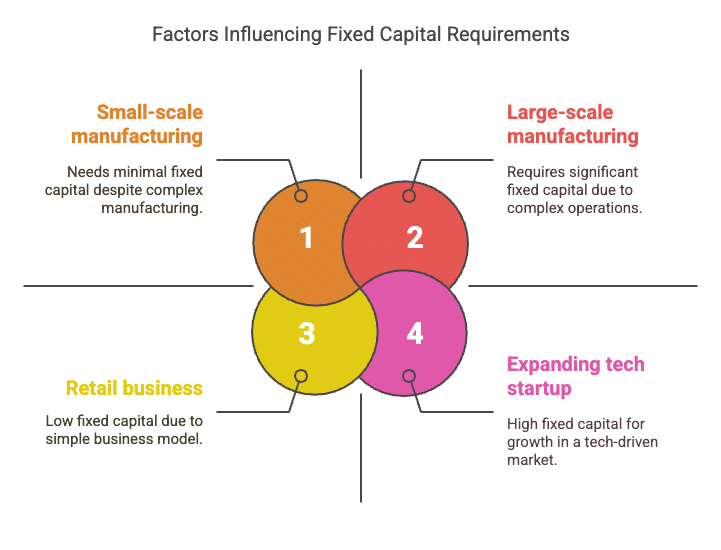
Factors Affecting Requirement of Fixed Capital:
1. Nature of Business: Manufacturing concerns require huge investment in fixed assets & thus huge fixed capital is required for them but trading concerns need less fixed capital as they are not required to purchase plant and machinery etc.
2. Scale of Operations: An organization operating on a large scale requires more fixed capital as compared to an organization operating on a small scale. For Example - A large-scale steel enterprise like TISCO requires large investment as compared to a mini steel plant.
3. Choice of Technique: An organization using capital-intensive techniques requires more investment in plant & machinery as compared to an organization using labour-intensive techniques.
4. Technology upgradation: Organizations using assets that become obsolete faster require more fixed capital as compared to other organizations.
5. Growth Prospects: Companies having more growth plans require more fixed capital. In order to expand production capacity more plant & machinery are required.
6. Diversification: In case a company goes for diversification then it will require more fixed capital to invest in fixed assets like plant and machinery.
7. Distribution Channels: The firm that sells its product through wholesalers and retailers requires less fixed capital.
8. Collaboration: If companies are under collaboration or joint venture, then they need less fixed capital as they share plant & machinery with their collaborators.
Working Capital
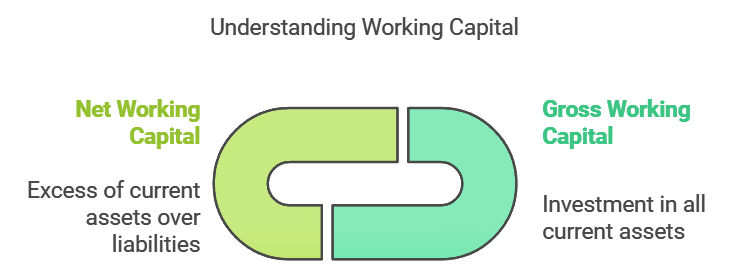
Working Capital refers to the capital required for day to day working of an organization. Apart from the investment in fixed assets every business organization needs to invest in current assets, which can be converted into cash or cash equivalents within a period of one year. They provide liquidity to the business. Working capital is of two types - Gross working capital and Net working capital. Investment in all the current assets is called Gross Working Capital whereas the excess of current assets over current liabilities is called Net Working Capital. The following are the factors which affect the working capital requirements of an organization:
1. Nature of Business: A trading organization needs a lower amount of working capital as compared to a manufacturing organization, as trading organization undertakes no processing work.
2. Scale of Operations: An organization operating on large scale will require more inventory and thus, its working capital requirement will be more as compared to small organization.
3. Business Cycle: In the time of boom more production will be undertaken and so more working capital will be required during that time as compared to depression.
4. Seasonal Factors: During peak season demand of a product will be high and thus high working capital will be required as compared to lean season.
5. Credit Allowed: If credit is allowed by a concern to its customers than it will require more working capital but if goods are sold on cash basis than less working capital is required.
6. Credit Availed: If a firm is able to purchase raw materials on credit from its suppliers than less working capital will be required.
7. Inflation: Working capital requirement is also determined by price level changes. For example, during inflation prices of raw material, wages also rise resulting in increase in working capital requirements.
8. Operating Cycle/Turnover of Working Capital: Turnover means speed with which the working capital is converted into cash by sale of goods. If it is speedier, the amount of working capital required will be less.
|
51 videos|230 docs|49 tests
|
FAQs on Financial Management Chapter Notes - Business Studies (BST) Class 12 - Commerce
| 1. What are the key components of financial management? |  |
| 2. How does financial management help in decision-making for businesses? |  |
| 3. What is the importance of financial management for individuals? |  |
| 4. How can financial management help in achieving long-term financial goals? |  |
| 5. What are the common financial management tools used by businesses? |  |
















